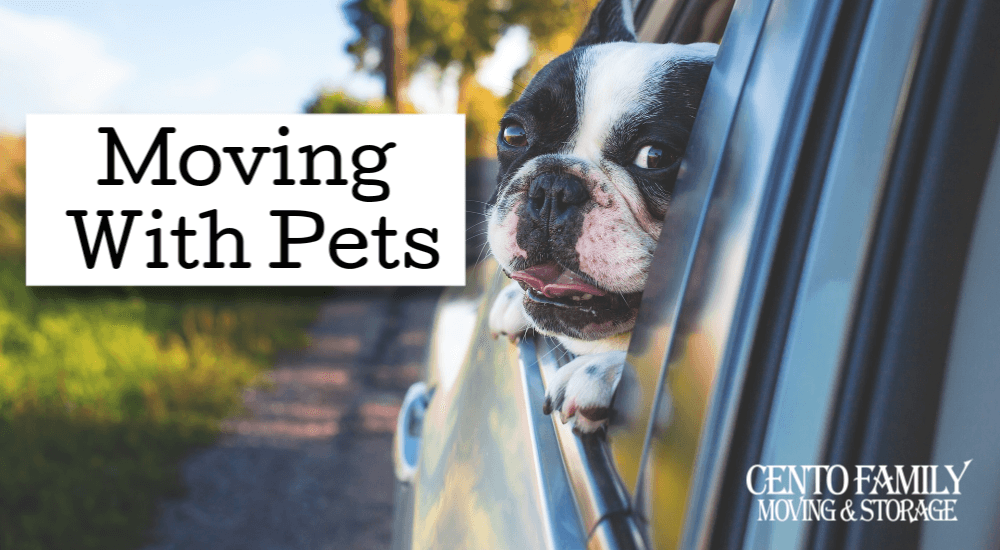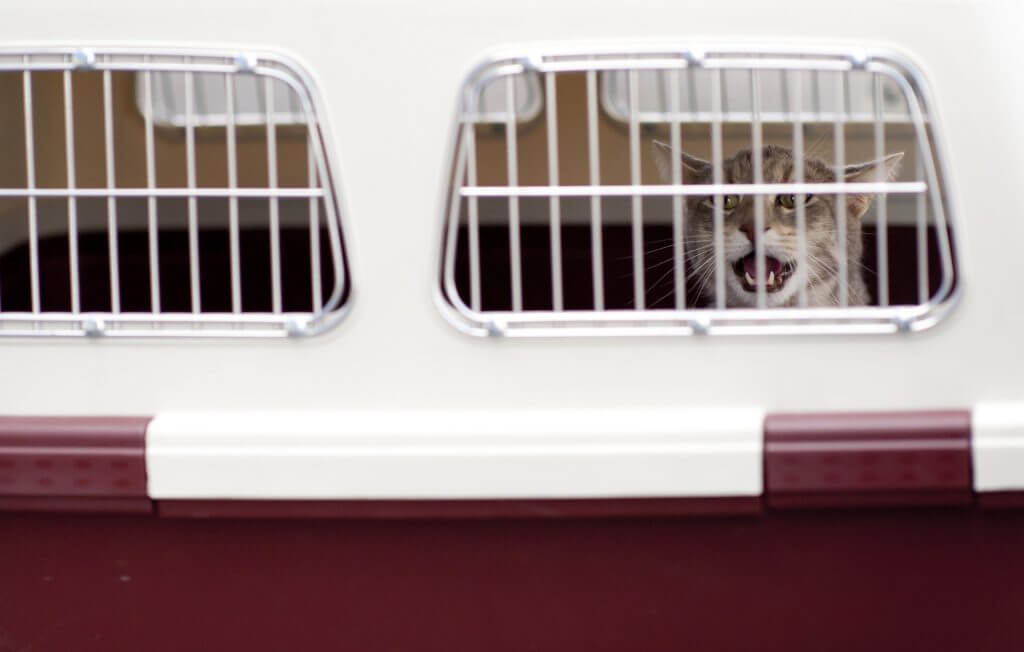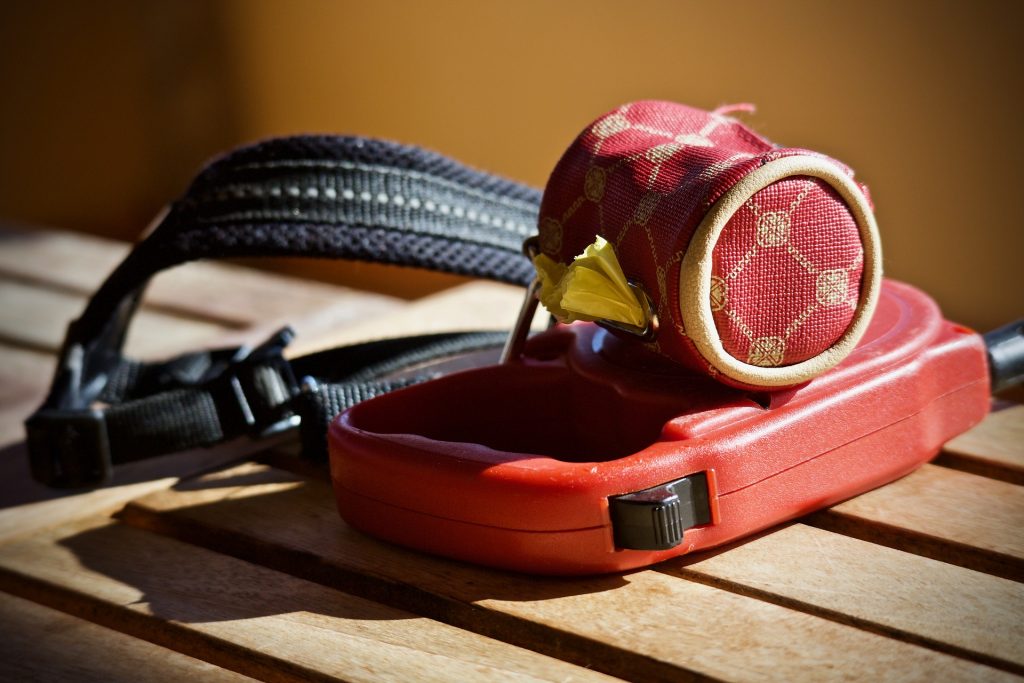Moving With Pets

If you’re like 68% of American pet owners, you consider Fido and Mittens to be members of your family.
So there’s no question that you’ll be moving with pets in tow. But how do you prepare your pets for a move?
You can’t sit them down for a nice chat to prepare them for the relocation, but it’s still important that you make moving as stress-free as possible for your dogs, cats, and other animals.
The following tips on moving with pets should ensure a happy, healthy transition for your four-legged family members.
1. Prepare Them For Moving
Unless you are using a pet relocation service, you will have to move your pets yourself. In fact, professional moving companies are prohibited by law from putting live animals onto a truck.
Start packing early, so your dogs and cats get used to the process (they’ll be seeing a lot of cardboard boxes in the coming weeks). If your pet has a favorite room or spot, pack it up last. Your pet should be the last thing into your car and the first thing out.
If your cat (or dog) is not used to traveling in a pet carrier, it’s best to acclimate them as soon as possible.
Leave a hard-sided kennel in a safe, out-of-the-way spot where your dog or cat can hide away. Provide tempting incentives inside the crate (food, treats, a favorite toy) to entice them to crawl in. Once they is used to it, start taking your pet for short drives within the neighborhood, preferably to a nice park or someplace fun so they start looking forward to the experience.
During the trip, drape a light sheet or blanket over the carrier to block kitty’s view of the windows. Watching the world whiz by at such a pace can be unnerving for cats.
2. Update Their Info
If you haven’t already microchipped your dogs and cats, now is a good time to do so. Microchips can be easily and quickly embedded into your pet’s skin so that veterinarians can locate you if your pet is lost.
Make sure your pet’s collar tag is updated with your phone number as well as the word “Reward!” as an extra incentive for your dog to be returned. Make sure your pets are wearing a collar at all times during the move, even if they don’t normally do so. No one ever plans for their pets to escape, so it’s best to be prepared at all times.
If you’re moving long distance, have your pet’s medical records transferred to their new vet. This is also a good time for a check-up to make sure they’re healthy and up-to-date on all vaccinations before moving day. (If you’re crossing state lines, consider asking your vet for a health certificate to prove your pet is disease-free.)
3. Make a Pet Essentials Kit
We always advise people to prepare a moving essentials kit containing everything they will need for the first few nights in the new house. This needs to include the essentials for every member of the family…including your pets!
The contents will vary depending on how long you are traveling and whether you’ll be driving or flying, but some standard items include:
- your pet’s new ID tag, collar, and leash;
- their regular food and treats;
- water (preferably water they are used to drinking, as new water can sometimes cause a temporary upset stomach);
- their bed;
- a blanket or any other comfort objects;
- carrier, seat belt, or other safety device;
- waste disposal bags (for longer trips);
- any prescriptions;
- favorite toys;
- litter;
- collapsible food and water dishes.
Having the essentials on-hand will make a trip easier on your and your furry friends.
4. Keep Them Out of the Way
Dogs and cats should be kept in a safe location for the entire move. When the moving crew is carrying heavy furniture and boxes through a door that’s constantly opening and closing, it’s too easy for your furry friend to escape (or get stepped on).
If you can, arrange for pet care with a pet sitter, vet, or boarding facility to keep them out of the way.
If you can’t, lock them away in an empty room with food, water, their bed, a litter box or puppy pad, and some favorite toys. Do the same at the new house and put a sign on the door to remind movers to keep it closed.
5. Keep Them Calm
Any animal can show signs of stress during a move to a new home, which can lead to accidents, injury, and aggression.
If you think your pet will have a difficult time transitioning, discuss medicinal options with your vet. They may recommend a product like a ThunderShirt or even prescribe anti-anxiety medication to keep your animals calm.
During transport, do not open your pet’s crate to soothe or comfort them. A stressed and anxious animal could take this opportunity to escape.
Tell your moving crew how to treat your animal. If they will be looking in on the action from behind a baby gate, you may need to remind them that your shih tzu will bite if a stranger tries to pet her.
Above all, remember: pets can sense your stress. If you are frazzled during the moving process, they will understand the move to be a danger. Set a good example by remaining calm and relaxed.
6. Settle In Gradually
Set up a room just for them first so your pet can get settled in right away. Having their favorites on-hand (a soft bed, a favorite toy, food and water) will help ease the transition.
Even if your dog or cat is used to roaming outside, keep them secured on a leash to gradually acclimate them to the neighborhood. Stressed dogs (and especially cats) have been known to run away in search of their “real” home.
During this time, it’s important to keep to your pet’s usual schedule. Walking and feeding them regularly will help them feel secure.
For cats, start them off in only one room of the house and gradually introduce more rooms. This gives them time to get used to the new home’s sights, sounds, and smells. Spend some quiet time with them at first, doing relaxed activities such as reading or watching TV.
If you’ll be keeping your cat’s litter box in a different room, move it there gradually (a foot or so each day) so your cat doesn’t lose track of it.
7. Moving Small Mammals
Moving your hamster, guinea pigs, rabbits or other small pets involves just as much consideration as moving a dog or cat.
Get a pet travel cage for your hamsters, guinea pigs, or rabbits. This is one occasion when bigger is not better; leave your pets enough room to turn around and lie down, but no more. Just as with dogs and cats, you should slowly acclimate your pet to the crate to prevent undue stress on moving day.
Provide your small mammal’s usual food in the crate, but remove the water bottle, as it could spill. Instead, provide treats such as cucumber or fruit to provide for their water needs. For longer trips, take out the water bottle during designated water breaks.
The crate will be most secure on the floor or strapped into the seat with a seat belt. Keep it out of direct sunlight to prevent your pets from overheating during a long trip.
8. Moving Fish
Moving your fish involves a bit of preparation, but can be simple if done correctly.
If you’re moving 1-6 hours away, buy some brand-new, clean 5-gallon buckets with tight-fitting lids. Clean and rinse them thoroughly to ensure that there is no residue left behind. These will be for your tank’s water. You’ll also want to pick up some plastic bags from the pet store to transport your fish.
The week before moving, change 20% of the water in the tank each day to make sure it is clean before it goes into the bucket. Two days before the move, stop feeding your fish to ensure that the water stays clean (if your fish are usually well-fed, they should do fine without food for this time).
On moving day, place each fish into its own plastic bag with water from the tank and secure the top. If you’ll be traveling longer than one hour, stop by the pet store to have them fill your bags with pure oxygen. Place the bags in an empty cooler with the lid on to regulate temperature.
Moving fish longer than six hours away from your home is not recommended, as it can be too difficult on them (and they may not survive the trip). In this case, it’s usually best to rehome your fish with a friend or local pet store and purchase new ones after the move.
9. Moving Birds & Reptiles
Even if your macaw can talk, you can’t exactly tell your bird that you’ll be moving. Instead, you’ll have to get them acclimated to the idea of being transported to a new place.
If you’ll be switching your bird or reptile to a travel cage for the move, allow him to spend some time in there for a little bit at a time to get used to it. Securely strap the travel cage into your car without any unnecessary items, as they can cause injury if you suddenly slam on the brakes.
Water bottles can leak or spill during car rides, so pack some fruit in a cooler to give your pets a source of hydration. For long distances, provide water breaks.
Keep the temperature in the car comfortable, as birds and reptiles are very sensitive to temperature. If you’re moving in warm weather, consider using a sun guard on the window.
10. Long-Distance Moving With Pets
Relocating across the state, country, or ocean brings with it another load of concerns when you’re bringing your furry friends with you.
If you’ll be flying to your new home, check with the airline before buying tickets to ask about their pet regulations. Ask whether they accept pets on-board and what the restrictions are. Some will allow you to keep your pets in the cabin with you, as long as they are under a certain weight. Others will require you to pet your pet in the cargo hold.
If you’ll be driving, locate pet-friendly hotels along your route. Make sure you are honest about your pet’s weight and breed.
If you’re uncomfortable with organizing long-distance air travel for your pet, consider hiring a pet transportation company to handle the logistics. They can advise you on the best steps to take to keep your animals safe during transport.
Not Keeping Your Pets
Sadly, sometimes life circumstances don’t allow us to take our pets with us when we move.
Whatever you decide, DON’T abandon your pets when you move. This happens all too often, but it is NEVER the best solution. If you can’t leave your pet (no matter the species) with a trusted friend or family member, take them to a reputable rescue center so they can be placed in a new home.
Conclusion
Moving with pets isn’t complicated, it just calls for some careful planning to make sure everyone arrives at the new home happy, healthy, and safe.
Preparing your dog, cat, or bird for the adventure is a lot like moving with your kids: by acclimating them to the process, ensuring their safety, and providing them with lots of familiar comforts, you can reduce the impact of a stressful move.
Recent Posts
- The Ultimate Guide to Packing Office Equipment April 12, 2024
- How to Find a Reliable Mover (and Avoid Scams!) April 5, 2024
- How Much Does It Cost To Move (Without a Moving Company)? March 13, 2024












